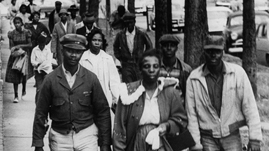Teachers' Domain - Digital Media for the Classroom and Professional Development
User: Preview


This media asset is from American Masters Harper Lee: Hey, Boo.
For more information on Director Mary Murphy and the Hey, Boo 45-minute classroom edition, visit Mary Murphy & Company.
Who’s Who in To Kill a Mockingbird: Southern Reaction 1960 (Document)
In this video segment, Andrew Young says that he didn’t need to read To Kill Mockingbird because he already knew the story—that essentially, he lived it. Young not only speaks of his own experience, but he also supports his statement with references to three atrocities committed against black men and civil rights leaders in the South around the time To Kill a Mockingbird was published. In the video, Young highlights the following tragic events leading up to and during the Civil Rights Movement:
Ask your students to complete a research assignment on one of these three events in United States History. Be sure students address the following in their research:
TEXT: TO KILL A MOCKINGBIRD WAS PUBLISHED ON JULY 11TH, 1960.
JANE CLARK: Well, when it came out in 1960 I wasn’t here. So when I started working here, then that’s a question we get a lot. So, I began asking people, "What did you think," you know? And most people said that they didn’t pay it any mind. I asked my mother, and she said, "well, it just seemed so familiar, we didn’t see anything special about it."
MARY TUCKER: I didn’t know that many people in the white community. I didn’t know their reaction to the book until much later. But I read the book as soon as it came out, and I got my hands on it. I was very much impressed. Not a lot of black people read the book.
ANDREW YOUNG: I didn’t need to read that. I knew what they were talking about. For somebody who didn’t know, okay. I had no intellectual curiosity about that. I had been through that with my wife, Id been through that with my father, and my grandfather. It was…it was too close to me. I remember Emmett Till, and all of that drama around that. I mean I was—I was a part of the march, around Jimmy Lee Jackson’s death and the missing, I mean the, the three civil rights workers: Schwerner, Goodman, and Chaney. There was too much horror around me at the time for me to absorb more.
JAMES MCBRIDE: What other writer during that time was willing to take on this subject with the kind of honesty and integrity that she did? What other white writer?
DIANE MCWHORTER: To write a book like this as a southerner is such an act of protest.
MARK CHILDRESS: We think of this book as being sort of a post-civil rights novel but it actually was published before the biggest explosions of the civil rights movement and helped bring them on.
SCOTT TUROW: This was a very brave book to have written when Harper Lee wrote it. She probably gets zero credit for it any more for speaking a truth that people, you know, 1959 1960 they were not ready to acknowledge.
NARRATOR: Schools, buses, restaurants, churches, and neighborhoods all were segregated.
REV.BUTTS: In Mobile as the pastor of the Michigan Ave. Methodist Church, I had gone through an encounter with the Klu Klux Klan who were after me because I signed a petition to integrate the buses there. And it was just a great comfort to those of us who had been involved in the civil rights movement that somebody from the Deep South had given us a book that gave some comfort to us and what we had done.
MARY TUCKER: we built our house in 1960. The black community where I lived was called the Morningstar Community. One Saturday night soon after we built our house in town, some white teenagers came through our neighborhood and threw a brick at our picture window. It missed the window, fortunately.
ANDREW YOUNG: We were aware of the harshness and brutality of segregation. Here in Birmingham—you had—for the first time black people making union wages in the steel mills. And they began to build nice homes. Now these were veterans of—of—of service in the military who came back, went to school, got good jobs, and started building nice little homes, nothing fancy, Just little three bedroom frame houses. And there were more than 60 of those houses dynamited. To Kill a Mockingbird sort of gave the background of that but it also gave us hope that justice could prevail.
 Loading Standards
Loading Standards